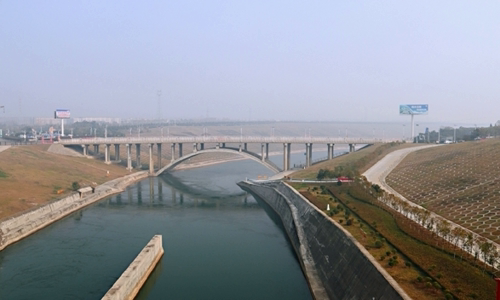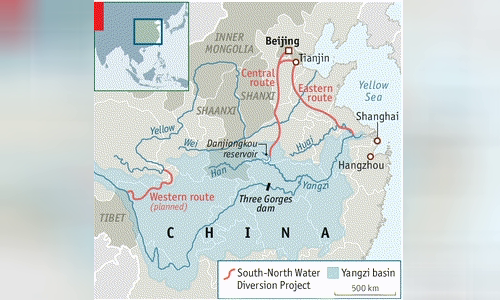Chinese officials aim to double the amount of water transferred from the southern floodplain to the arid north, so that there is enough water to consume.
Preliminary work for the second phase of the water transfer project is underway, aiming to increase the transport capacity from 8.77 billion cubic meters of water to double, reaching 16.5 billion cubic meters, Shi Chunxian, chief of the next department. China Ministry of Water Resources said at a news conference in Beijing yesterday.

A section of the canal carries water from south to north of China Photo: China.org.cn
The second phase will provide water for Anhui and Shandong provinces as well as areas around Beijing. Shi added that China will make use of existing infrastructure to limit its environmental impact.
The South-North Water Transfer Project was first launched by China in 1952 to address flooding in the south and arid in the north, but many critics of the project are costly and can cause pollution. contamination of rivers and lakes in other areas.
The first phase of the project was operated five years ago, connecting the Yangtze and the Yellow River through two major canals in eastern and central China. The second phase is expected to face many challenges as it draws water to the far west.
The project has so far transported a total of 30 million cubic meters of water to the north, serving the daily life of 120 million people, said Zhang Youguang, China's Vice Minister of Water Resources.
However, about 345,000 people were forced to relocate to make way for the project. Critics say the project does not solve China's problems, including excessive water consumption in industrial activities as well as poor urban plumbing.
Many Chinese cities are increasingly dependent on complex water transfer plans. The country still prioritizes large-scale construction, rather than focusing on addressing pollution, improving water conservation and increasing productivity.

Two existing water routes in the South - North project and the western one are planned to be built Photo: Economist
"Replacing near-unattractive underground pipelines with the construction of a water transfer system between the world's largest river basins," said Darrin Magee, a professor at Hobart University and William Smith, USA, who is knowledgeable. water issues in China.
Two existing water routes in the South - North project and the western one are planned to be built. Graphics: Economist.
China's water resource per capita is about one quarter of the world average. Prime Minister Li Keqiang said last month that the new irrigation canal was necessary for moving more water to the north and addressed concerns about lack of irrigation resources.
The construction of an emergency expansion project has been started, helping to transfer about 490 million cubic meters of water each year to Beijing and surrounding areas. Beijing has relied on the water transfer project to provide 70% of the water and this could increase to 95%.
Although President Xi Jinping called for an end to large-scale development projects around the Yangtze basin, the plan to expand the water transfer seems to continue.
"I think greening the Yangtze area is definitely a priority, but it is not considered as urgent as ensuring enough water for Beijing and Tianjin, in terms of social stability," Magee said.



 HannahFatunase
HannahFatunase







